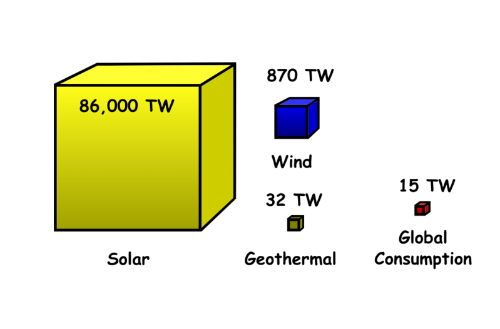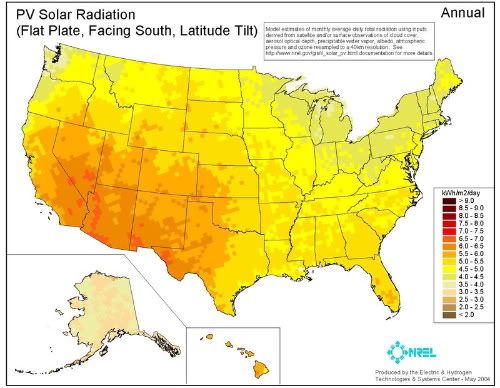So much for the problems- what are some of the solutions? A number of options exist or are being developed on the alternative energy front. Purely from an energy standpoint, renewable sources are more than capable of providing our energy needs; the issue at this point is refining our alternative energy technologies to the point where we can harness a significant fraction of that energy. Solar irradiance (the amount of solar energy that reaches the surface) is about 145 watts per square meter; when you take into account atmospheric variables, the usable amount of solar energy received for locations in the USA ranges from 4 to 7 kilowatt-hours per square meter per day for a flat-plate solar array. At the present, the maximum efficiency for solar power systems of any type is about 40%, though there are some technologies that promise even higher efficiencies. At 40%, that translates to 1.6 to 2.8 kilowatt-hours per square meter per day.
Looking at the EIA’s figures for household energy usage in 2001, it would appear that this energy demand could be met by thirty eight square meters per household (based on a 25% efficiency rating rather than the 40% maximum) or just under three million acres; to put this in perspective, thatt is less than the size of the area of the National Petroleum Reserve in Alaska that the U.S. government opened up to drilling in July. This would be why DARPA is taking another look at space-based solar power. Given current and emerging trends in energy availability combined with the average efficiencies now available (and the undiluted, unscreened sunlight that’s available in space), it doesn’t look quite so ridiculous any longer.
Wind power is starting to come into its own, as well. Today’s windmills owe little to their forebears except for concept. Wind power’s lack of required infrastructure at ground level has made it a popular choice among farmers (and even some towns) in areas of relatively low relief and high wind speed. Small-scale wind generators are available for homes, and a hybrid solar/wind strategy combined with battery storage would provide reliable, consistent round-the-clock power. Offshore sites have especially high potential for wind power, as this map demonstrates.
Other articles have already addressed both space-based solar and offshore wind power, I refer you to those for in-depth information. [ad name="Adsense Small Horz Banner"] Water issues could be addressed in a number of ways. Permeable pavement technology is already being used “in the field” and research is ongoing, though weight and speed-related restrictions keep it from being used for roads and highways. Runoff collection systems such as rain barrels and the like are another effective solution. Perhaps the best solution of all is to utilize native plants to control water conditions at a site. Stormwater management can also be handled by creating rain garden-like buffer zones and landscaping with native plants- the deeper the root structure, the better! Vegetation also helps to create clouds through transpiration. Polyculture and permaculture farming methods reduce the need for chemical inputs, which decreases the amount of pollution downstream.
Improved runoff control would also address the issue of soil erosion, and no-till farming methods (exactly what the name implies) keep soil structure and organisms intact; in the long run, maintaining the soil ecology helps to continuously renew the soil’s store of nutrients.
One straightforward, though undoubtedly less popular, means of increasing the amount of food that can be produced on the available arable land is to lower meat consumption- the rule of thumb is that, for each level you move up the food “chain”, about 80-90% of the usable energy is lost. (Coincidentally, environmental contaminants become more concentrated as you ascend the chain, which is the reason for heavy metal contamination of fish such as tuna.) Because of that efficiency drop, it takes far more land to produce a given amount of calories via meat. Commercial meat production also generates vast amounts of waste, yet another (controllable) source of environmental pollution.
As I've given evidence to here, there are many ways in which we can curb our effects on our world and achieve long-term sustainability and viability; it remains to be seen whether we will choose to do so or not.


